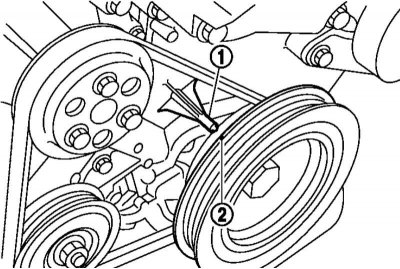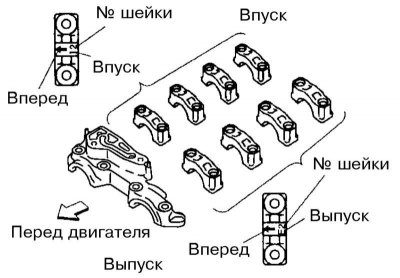Camshaft Installation Components

1 - Upper bearings No. 2-5 camshafts; 2 - Upper support No. 1 of camshafts; 3/4 - Inlet / outlet camshaft; 5 - Valve lifters; 6/7 - Intake / exhaust camshaft sprocket; 8 - Timing chain tensioner; 9 - Front cover of the cylinder head; 10 - Timing chain; 11 - Cylinder head; 12 - O-ring; 13 - Camshaft position sensor (CMP)
Removing
1. Remove the locker of the right front wheel arch (see chapter Body).
2. Secure the engine by installing lifting eyes on it and hanging it from the winch. Alternatively, you can support the engine with a jack. Remove the right engine mount and the right upper bracket (see Section Removal and installation of the power unit).
3. Remove the cylinder head cover (see Section Removal and installation of a cover of a head of cylinders).
4. If necessary, remove the CMP sensor from the rear of the cylinder head.
Note. Handle the sensor carefully; its end is magnetic, so do not allow metal particles to stick to it.
5. Remove the right headlight (see chapter Onboard electrical equipment).
6. Remove the front cylinder head cover.
7. Set the piston of the first cylinder to the TDC position of the compression stroke, as described in paragraphs 8 to 10.

8. Turn the crankshaft pulley clockwise until the mark (2) TDC on the pulley coincided with the indicator (1) TDC on the front cover of the cylinder block.

9. Make sure that the TDC marks on the camshaft sprockets are located as shown in the illustration. Otherwise, turn the crankshaft pulley one more turn.
10. After the TDC marks on the camshaft sprockets are located as shown in the illustration above, apply the corresponding marks on the timing chain links with paint or a marker.

11. Removal and installation of the intake camshaft sprocket assembly should be carried out only if the timing regulator is in the maximum advance position. With the engine off, the regulator (3) is in the position of maximum delay and does not rotate, because locked on an asterisk (1) internal pin (2). If the intake camshaft sprocket assembly mounting bolts are loosened or tightened in the above situation, the inner pin will be damaged, resulting in malfunctions due to the increased horizontal load on the pin. To set the sprocket assembly to the maximum advanced position, follow the procedures in paragraphs 12 to 15. The timing chain tensioner must not be removed when doing this.

12. Install a key on the hex part of the intake camshaft and hold the shaft from turning with it.

13. With hand pump (2), connected to the intake valve timing oil passage on the top surface of the No. 1 camshaft bearing, pressurize not less than 3 atm, to bring the pin to the unlocked position. Maintain pressure while performing the procedures below.
14. Slowly turn the intake camshaft counterclockwise, looking from the front of the engine, i.e. towards the intake manifold. As soon as a click is heard from the sprocket assembly, which means the phase regulator is unlocked, or the regulator begins to rotate independently on the sprocket, turn the camshaft in the opposite direction (to exhaust pipe), to set the maximum advance position of the timing regulator. If it does not unlock, lightly shake the key holding the camshaft, or very gently tap with a plastic-headed hammer on the front of the camshaft.

15. The phase regulator is in the maximum advanced position, when it can rotate freely, and the sprocket rotates with the camshaft. At the same time, the label (1) regulator (3) must match label (2) asterisks.

16. Insert a paper clip (1) into the tensioner (2) timing chain to lock the tensioner rod in the fully compressed position, and then remove the tensioner.

17. Holding the camshaft by the hexagon, unscrew the bolts securing the camshaft sprockets and remove the sprockets. When removing the intake camshaft sprocket, do not allow the phase adjuster to rotate so that it does not lock in the maximum retard position. Do not force or disassemble the intake camshaft sprocket assembly (do not remove the 4 front bolts).

18. Remove the upper camshaft bearings by unscrewing the bolts in sequence, reverse indicated in the illustration.
19. Remove camshafts. When doing this, be careful not to deform the signal plate at the rear end of the intake camshaft.
20. Remove and position the valve lifters so that they can then be installed in their original locations.
Examination
1. Lay the camshaft with journals No. 2 and No. 5 in the grooves of a special stand and, by rotating the shaft, measure the radial runout of the neck No. 3. Compare the result with the requirements Specifications and replace the shaft if necessary.
2. Measure the height of the camshaft cams and the diameter of the camshaft journals with a micrometer. Write down the received data. Install the upper camshaft bearings and measure the inner diameter of their bearings formed by the upper bearings and grooves in the cylinder head. By subtracting the diameter of the corresponding journal from the inner diameter of each camshaft bearing, calculate the backlash values of each journal in the bearing. Install the shafts on the cylinder head and check their axial play by moving the shafts back and forth by hand. Compare your results with requirements Specifications and if necessary, replace the camshaft and/or cylinder head assembly with the upper camshaft bearings.
3. Lay the camshaft with journals No. 2 and No. 5 in the grooves of a special stand and, rotating the shaft, check the axial runout of its sprocket. Compare the received value with the requirements Specifications and replace the sprocket if necessary.
4. Check the outer surfaces (cylindrical and flat) valve lifters for cracks and signs of wear. Measure the outside diameter of each pushrod and the inside diameter of the corresponding groove in the cylinder head. Subtracting the first value from the second value, calculate the play of each valve lifter in the seat. If necessary, replace the tappet or cylinder head assembly with the upper camshaft bearings.
Installation
1. Establish pushers of valves on their former places.

2. Clean the lower bearing surfaces of the camshafts (on the cylinder head) and install them with the hole oriented (1) on the intake shaft and pin (2) on the exhaust shaft as illustrated.

3. The intake shaft can be distinguished from the exhaust shaft by looking at their ends. In addition, on the camshafts between the cams of cylinders No. 2 and No. 3 (engines 1.0 l and 1.2 l) or #3 and #4 (engines 1.2 l and 1.4 l) there are color marks: on the intake shaft - green, and on the exhaust - white (engine 1.0 l) or red (engines 1.2 l and 1.4 l).

4. Clear working surfaces of the top support of camshafts and establish them on former places. The arrows on the supports must point in the direction of the front of the engine (timing chain). The supports can be identified by the marks applied to them: the letter I or E means belonging to the intake or exhaust shaft, respectively, and the number after the letter indicates the number of the shaft journal (numbering starts from the timing chain).

5. Tighten the bolts of the upper camshaft bearings: first - No. 9-12 with a force 2.0 Nm, then all the bolts in the specified sequence with a force 5.9 Nm, and finally tighten all the bolts in the specified sequence with a force 9.0÷11.8 Nm.
Note. The bolts have different lengths and the corresponding color: ##1-10 are black, and #11 and #12 are golden.

6. Install the intake camshaft sprocket assembly and make sure that the marks for the position of the maximum advance of the phase regulator match.
Note. The pin on the back of the sprocket assembly must fit into the corresponding hole on the shaft flange.
7. Install the timing chain on the intake camshaft sprocket so that the mark on the chain matches the mark on the sprocket.

8. While holding the camshaft from turning, tighten the sprocket assembly mounting bolt and remove the tape that fastens the sprocket to the phase regulator from the assembly (if installed).
9. Install the exhaust camshaft sprocket.
Note. The pin on the shaft flange must fit into the corresponding hole on the back of the sprocket.

10. Install the timing chain on the exhaust camshaft sprocket so that the mark on the chain matches the mark on the sprocket. While holding the camshaft from turning, tighten the sprocket mounting bolt.
11. Make sure that the marks on the timing chain match the marks on the camshaft sprockets.
12. Install the timing chain tensioner and remove the clip inserted during removal from it. Once again, make sure that the marks on the timing chain match the marks on the camshaft sprockets.
13. Turn the crankshaft pulley clockwise to set the inlet valve timing adjuster to the maximum retard position. When this position is reached, the adjuster and the intake camshaft sprocket should rotate at the same time. Check that the adjuster is locked in this position by turning the crankshaft pulley counterclockwise - the adjuster and sprocket should rotate at the same time.

14. Apply a bead of sealant with a diameter of 2-3 mm to the mating surface of the front cover of the cylinder head and install the front cover so that the holes in it coincide with the corresponding pins of the cylinder head.
15. Install the CMP sensor making sure its O-ring and mating surfaces are clean.
16. Further installation is carried out in the reverse order to the dismantling of the components.